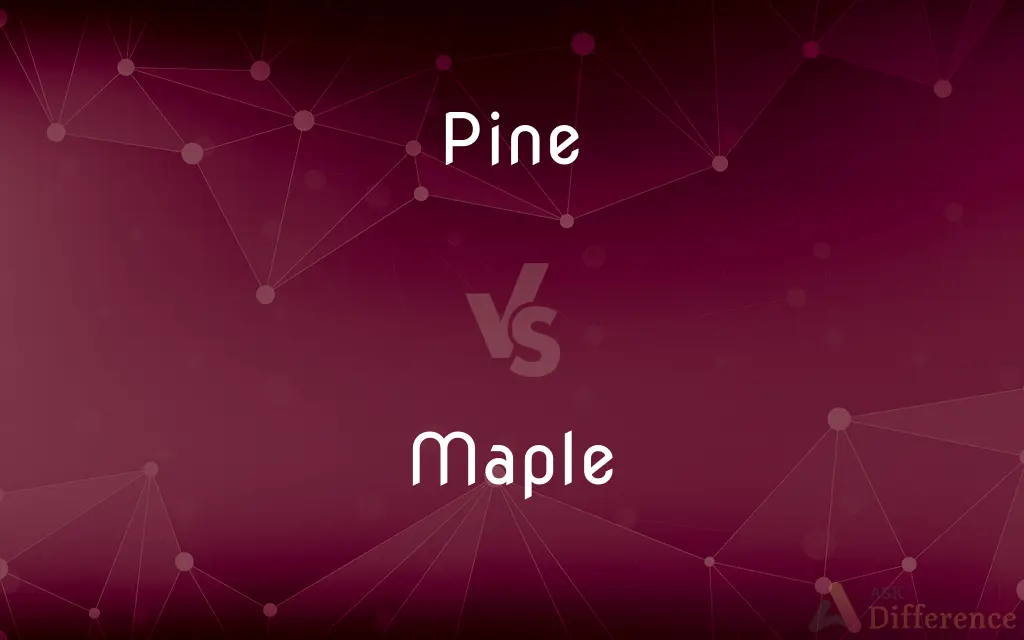Pine vs. Maple — What's the Difference?
Edited by Tayyaba Rehman — By Fiza Rafique — Updated on April 18, 2024
Pine is a softwood known for its affordability and ease of use, ideal for rustic furniture, while maple is a hardwood, valued for durability and fine grain, popular in high-end furniture and flooring.

Difference Between Pine and Maple
Table of Contents
ADVERTISEMENT
Key Differences
Pine wood is generally softer and more susceptible to dents and scratches, which makes it less suitable for flooring that requires high durability. On the other hand, maple is one of the harder woods, often chosen for its resilience and ability to withstand heavy use.
Pine tends to have a lighter color with a more pronounced grain, giving it a warm, rustic appeal. This makes it popular in casual, country-style decor. Whereas, maple usually has a finer, more uniform grain and can range from creamy white to a light reddish-brown, suiting both modern and traditional interiors.
Pine is typically less expensive than maple, which can make it a more cost-effective option for large scale projects or for those on a budget. On the other hand, maple, due to its hardness and aesthetic qualities, often comes with a higher price tag.
When it comes to working with the wood, pine is easier to cut, carve, and shape due to its softness, making it a favorite among novice woodworkers. Maple, while more challenging to work with, yields high-quality finishes that are preferred in fine woodworking and cabinetry.
Pine wood releases a pleasant pine scent, especially when freshly cut, which is a characteristic appreciated in certain applications like crafting holiday decorations. In contrast, maple does not emit as distinct an aroma, making it neutral for use in environments where smell is a consideration.
ADVERTISEMENT
Comparison Chart
Type of wood
Softwood
Hardwood
Hardness
Softer, prone to scratches
Harder, highly durable
Color & Grain
Light color, pronounced grain
Creamy to reddish, fine grain
Cost
Generally less expensive
More expensive
Workability
Easier to work with
Requires more skill
Compare with Definitions
Pine
Releases a natural resin that can affect painting and staining.
We had to thoroughly sand the pine shelves before applying a coat of paint.
Maple
A type of hardwood used in furniture, flooring, and musical instruments.
The maple guitar had a clear, bright tone prized by musicians.
Pine
Grows faster and is more sustainable than many hardwoods.
Pine is often used in eco-friendly building projects.
Maple
Resistant to wear and tear, making it ideal for high-traffic areas.
They installed maple flooring in the kitchen to withstand the daily foot traffic.
Pine
A type of softwood commonly used in construction and furniture.
The carpenter chose pine for the farmhouse table because of its rustic look.
Maple
Typically more expensive than softwoods like pine.
The choice of maple for the dining table increased the overall cost of the room's furnishings.
Pine
Known for its distinctive knots and grain.
The pine wood's knots added character to the wooden floor.
Maple
Has a smooth, uniform grain that is aesthetically pleasing.
The maple cabinets were chosen for their sleek and modern appearance.
Pine
Has a natural scent that is often associated with cleanliness and freshness.
The smell of fresh pine was evident in the newly constructed cabin.
Maple
Requires specific tools for processing due to its hardness.
The woodworker used specialized blades to cut through the hard maple.
Pine
A pine is any conifer in the genus Pinus () of the family Pinaceae. Pinus is the sole genus in the subfamily Pinoideae.
Maple
Acer is a genus of trees and shrubs commonly known as maples. The genus is placed in the family Sapindaceae.
Pine
An evergreen coniferous tree which has clusters of long needle-shaped leaves. Many kinds are grown for the soft timber, which is widely used for furniture and pulp, or for tar and turpentine.
Maple
Any of various chiefly deciduous trees or shrubs of the genus Acer of the Northern Hemisphere, having opposite, usually palmate leaves and fruits consisting of paired seeds attached to long wings.
Pine
A pineapple.
Maple
The wood of any of these trees, especially the hard, close-grained wood of the sugar maple, often used for furniture and flooring.
Pine
Suffer a mental and physical decline, especially because of a broken heart
She thinks I am pining away from love
Maple
The flavor of the concentrated sap of the sugar maple.
Pine
Any of various evergreen trees of the genus Pinus, having fascicles of needle-shaped leaves and producing woody seed-bearing cones. These trees are widely cultivated for ornament and shade and for their timber and resinous sap, which yields turpentine and pine tar.
Maple
A tree of the genus Acer, characterised by its usually palmate leaves and winged seeds.
Pine
Any of various other coniferous trees, such as the Norfolk Island pine.
Maple
The wood of such a tree, prized for its hardness and attractive appearance
Pine
The wood of any of these trees.
Maple
A tree of the genus Acer, including about fifty species. Acer saccharinum is the rock maple, or sugar maple, from the sap of which sugar is made, in the United States, in great quantities, by evaporation; the red maple or swamp maple is Acer rubrum; the silver maple, Acer dasycarpum, having fruit wooly when young; the striped maple, Acer Pennsylvanium, called also moosewood. The common maple of Europe is Acer campestre, the sycamore maple is Acer Pseudo-platanus, and the Norway maple is Acer platanoides.
Pine
Intense longing or grief.
Maple
Wood of any of various maple trees; especially the hard close-grained wood of the sugar maple; used especially for furniture and flooring
Pine
To feel a lingering, often nostalgic desire.
Maple
Any of numerous trees or shrubs of the genus Acer bearing winged seeds in pairs; north temperate zone
Pine
To wither or waste away from longing or grief
Pined away and died.
Pine
To grieve or mourn for.
Pine
Any coniferous tree of the genus Pinus.
The northern slopes were covered mainly in pine.
Pine
(countable) Any tree (usually coniferous) which resembles a member of this genus in some respect.
Pine
(uncountable) The wood of this tree.
Pine
A pineapple.
Pine
(archaic) A painful longing.
Pine
(intransitive) To languish; to lose flesh or wear away through distress.
Pine
(intransitive) To long, to yearn so much that it causes suffering.
Laura was pining for Bill all the time he was gone.
Pine
(transitive) To grieve or mourn for.
Pine
(transitive) To inflict pain upon; to torment.
Pine
Woe; torment; pain.
Pine
Any tree of the coniferous genus Pinus. See Pinus.
Pine
The wood of the pine tree.
Pine
A pineapple.
Pine
To inflict pain upon; to torment; to torture; to afflict.
That people that pyned him to death.
One is pined in prison, another tortured on the rack.
Pine
To grieve or mourn for.
Pine
To suffer; to be afflicted.
Pine
To languish; to lose flesh or wear away, under any distress or anexiety of mind; to droop; - often used with away.
Pine
To languish with desire; to waste away with longing for something; - usually followed by for.
For whom, and not for Tybalt, Juliet pined.
Pine
A coniferous tree
Pine
Straight-grained durable and often resinous white to yellowish timber of any of numerous trees of the genus Pinus
Pine
Have a desire for something or someone who is not present;
She ached for a cigarette
I am pining for my lover
Common Curiosities
How resistant are pine and maple to humidity and temperature changes?
Maple is more resistant to humidity and temperature fluctuations, making it less likely to warp or split compared to pine.
What types of finishes work best on pine and maple?
Pine absorbs stains unevenly due to its softness and resin content, often requiring a pre-stain conditioner for best results. Maple, with its fine grain, takes finishes smoothly, making it ideal for a variety of stains and varnishes.
Can I use maple wood for outdoor furniture?
Maple is generally not recommended for outdoor furniture unless treated with weather-resistant finishes, as it doesn't naturally resist decay as well as some other woods.
What is the price difference between pine and maple flooring?
Maple flooring is typically more expensive than pine due to its durability and aesthetic appeal, which are considered superior for high-end installations.
How do the environmental impacts of harvesting pine and maple compare?
Pine, being a fast-growing softwood, generally has a lower environmental impact and is more sustainable. Maple trees grow slower and require more time to reach maturity, which can make their harvesting more impactful on forests.
Are there any health considerations when working with pine or maple wood?
Both woods can produce sawdust that is irritating to the lungs and skin. Maple sawdust, however, is generally considered more allergenic than pine.
Is pine suitable for making fine furniture?
While pine can be used for fine furniture, it is more commonly used for rustic or distressed-style pieces due to its softness and tendency to show wear.
How do pine and maple react to woodworking tools?
Pine, being softer, is easier to cut and shape with common woodworking tools, whereas maple requires sharper tools and more expertise due to its hardness.
What are the best climates for growing pine and maple trees?
Pine trees are adaptable and can grow in a variety of climates, while maple trees prefer temperate climates and are commonly found in the northeastern United States and Canada.
What is the fire resistance of pine vs. maple?
Both woods are susceptible to fire, but maple’s higher density gives it a slightly slower burn rate compared to pine.
Which wood is more popular for cabinetry, pine or maple?
Maple is more popular for cabinetry due to its fine grain, strength, and the high-quality finish it can achieve, which are essential for cabinetry.
How long do pine and maple trees take to mature?
Pine trees mature much faster than maple trees, taking about 25-30 years compared to 30-40 years for maple, impacting their sustainability and cost.
Which wood is easier to maintain, pine or maple?
Maple is easier to maintain due to its durability and resistance to scratching and denting, requiring less frequent refinishing compared to pine.
How do pine and maple affect the acoustics of musical instruments?
Pine is rarely used in musical instruments due to its softness and lack of density. Maple, being dense and hard, is preferred for its ability to produce a clear, consistent sound, especially in string instruments and pianos.
Can pine be used for heavy-duty structures?
While pine can be used for structural purposes, its softness and lower strength compared to hardwoods like maple make it less ideal for heavy-duty or load-bearing structures.
Share Your Discovery

Previous Comparison
Even vs. Evening
Next Comparison
Flew vs. FliedAuthor Spotlight
Written by
Fiza RafiqueFiza Rafique is a skilled content writer at AskDifference.com, where she meticulously refines and enhances written pieces. Drawing from her vast editorial expertise, Fiza ensures clarity, accuracy, and precision in every article. Passionate about language, she continually seeks to elevate the quality of content for readers worldwide.
Edited by
Tayyaba RehmanTayyaba Rehman is a distinguished writer, currently serving as a primary contributor to askdifference.com. As a researcher in semantics and etymology, Tayyaba's passion for the complexity of languages and their distinctions has found a perfect home on the platform. Tayyaba delves into the intricacies of language, distinguishing between commonly confused words and phrases, thereby providing clarity for readers worldwide.














































